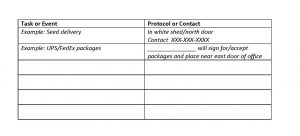Agriculture in Wisconsin is a leading industry generating $104 billion per year. Farms are the origin of the food industry. The health of farmers is instrumental at the start of a safe and secure food system. For this reason, farmers and those providing service to farms are identified as essential for Americans. Farms should consider all avenues of potential virus spread and develop protocols to reduce risk of disease. There are no boundary lines for diseases, so precautions are needed and not use “we are rural” for not taking precautions.
Farms need to follow their biosecurity plans and protocols. If a farm does not have a biosecurity plan, one should be developed as soon as possible. Additional biosecurity resources are available here. Follow all recommended cleaning, sanitizing, and hand washing protocols.
Farm service providers
- Develop a protocol when service providers arrive on the farm. These protocols will vary for different providers
- Providers should have phone numbers for the contact person responsible. Depending on size of operation, it may all go to the farmer or may have shared responsibilities.
- Product providers such as feed, seed, fertilizer, and crop protection products should be informed ahead of arrival onto the farm where product should be delivered, unloaded, or applied, in order to allow proper physical distancing with farmers or employees. This practice will help reduce risk to the service provider employee too.
- Provide veterinarians and animal care professionals with specific directions of where animals are located, location to park, and who to contact upon arrival.
- Attempt to keep enough resources on hand to be able to manage if backups are needed. This will minimize the number of times suppliers need to visit the farm. Have replacements for essential items at the farm to carry for a period should regularly scheduled replacement be disrupted.
- Post areas that service providers are not allowed to access. Restricted areas should include employee break room, bathroom facilities, offices, and any other areas frequently used by employees and family members of the farm.
- Practice cleaning and sanitation practices as supplies and packages are delivered to home, farm, and office areas.
Daily correspondence
- Consider handling of daily mail, delivery of packages, and dealing with invoices, develop a protocol for individuals who handle these or similar tasks. Consider the time of day when these tasks get done to minimize interaction with others doing other tasks.
- Payment processing is another task to consider. Reduce handling of paper by switching accounts to online payments.
- If unplanned purchases are needed, consider who is the contact person to handle the purchase or request.
- Utilize email/text as much as possible to receive feed rations and other information rather than meeting face to face.
- Determine delivery or reception points. Use signage to direct individuals arriving on your farm to express respect for social and physical distancing parameters and provide a meeting location.
- Email/text or make delivery notes for on-line purchases with directions ahead of the delivery arriving to your farm.
- Respectfully share with visitors, including salespeople, neighbors, etc., your concerns about disease spread and ask that they call or email/text.
Task sheet
A task and protocol list can help farmers and employees understand and follow proper procedures to help reduce the risk of arrival and spread of COVID-19 around the farm. An example task sheet is below. A template is provided for farms to customize for their farm.




